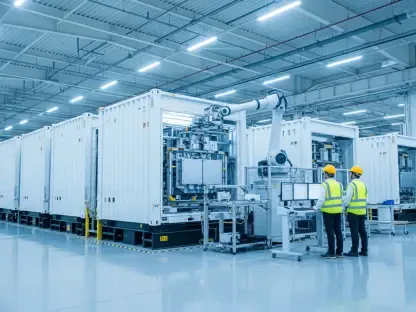The fusion of technology and sustainability is reshaping the parameters of digital infrastructure—a synergy essential to addressing environmental and operational challenges in contemporary markets. This evolving paradigm is exemplified by Meta’s recent strategic collaboration to harness solar energy in Texas, delivering a dual promise of efficiency and ecological stewardship. Beyond merely harnessing power, this alignment promotes an enhanced, more sustainable power grid—an urgent necessity in an era where digital operations remain unyielding in their energy demands. Companies across the globe are now more than ever integrating eco-responsibility into their core values, ensuring that as digital landscapes evolve, they do so progressively, embracing green initiatives without compromising on performance or reliability.
Meta’s Solar Inroads in Texas
Harnessing Renewable Potential
Meta’s initiative in Texas aligns with the broader industry trend that sees a growing number of technology giants turning to renewable sources to power data-driven infrastructure. Their choice to integrate solar energy reflects a commitment to sustainable practices while employing strategic regional partnerships to drive this agenda forward. The solar energy project in Texas is not merely symbolic; it represents a tangible move toward cleaner energy use, reducing reliance on traditional fossil fuels that contribute significantly to carbon emissions. By investing in these solar solutions, Meta sets a precedent for other technology firms grappling with the environmental impact of digital infrastructure’s growth, evidencing how innovative collaborations can lead to sustainable transformation.
Strategic Collaborations and Outcomes
Engaging in these collaborations provides Meta with a strategic edge in both the digital and energy markets. The partnership for solar deployment in Texas exhibits how industry players can effectively incorporate environmental, social, and governance (ESG) criteria into their operations, positively influencing their entire stakeholder ecosystem. This move not only enhances Meta’s reputation and aligns with their sustainability goals but also contributes to building a more resilient power grid in Texas. The economic and social implications of this development resonate widely, indicating that strategic initiatives of this nature are essential for future growth and stability. By focusing on long-term sustainability, this emphasizes a shift toward more collaborative industry practices.
Innovations and the Digital Infrastructure Ecosystem
Technology Leaders Driving Change
Several technology companies are setting benchmarks in promoting sustainability within digital infrastructure. Vertiv, for instance, is devising comprehensive solutions that span both hardware and software, addressing pivotal issues within data centers and communication networks. Their global approach to efficient operations underscores the imperative to innovate responsibly, accommodating both market demands and environmental considerations. As digital infrastructure becomes increasingly crucial to global connectivity, this commitment to eco-friendly practices asserts Vertiv’s role as a frontrunner in delivering sustainable technology solutions that protect both efficiency and environmental integrity.
Emerging Workloads and Connectivity
Stelia, another key player in this space, pioneers Internet 3.0 by enhancing connectivity for emerging workloads. This ambition to form a software-defined network community showcases their attempt to fuse connectivity advancements with sustainability imperatives. As they focus on creating robust, energy-efficient networks, Stelia’s initiative signifies a leap into a future where digital expansion is seamlessly integrated with environmental consciousness. The capacity to adapt and implement such innovative solutions will prove vital for navigating the increasing demands of modern digital ecosystems. Their efforts act as a blueprint for other entities seeking to sustainably manage the rising complexities of global digital networks.
The Future of Digital Landscapes: A Sustainable Perspective
A Collective Movement Toward Green Solutions
Virtus Data Centers, a part of ST Telemedia Global Data Centers, echoes this commitment to sustainability through meticulous advancement in their digital infrastructure across Europe. This emphasis on operational excellence and eco-friendly practices demonstrates a strategic shift toward energy-efficient solutions that align with evolving environmental regulations and consumer expectations. Virtus’s dedication to sustainable practices is a testament to the industry-wide pivot toward battling climate change challenges while ensuring uninterrupted digital service. Their progressive initiatives are indicative of the broader movement within the sector, one where sustainability and operational efficiency converge to redefine the parameters of digital infrastructure.
Strategic Positioning in Evolving Markets
The dynamic convergence of green initiatives and technological innovation presents viable pathways for industries as they adapt to changing market dynamics. Companies like Meta and Virtus are crafting strategies that not only address immediate environmental needs but position themselves strategically for future market dominance. This visionary approach underscores an industry-wide understanding that sustainable digital solutions are not just beneficial but necessary. As more companies recognize the critical importance of these strategies, the digital and energy markets will likely see a surge in similar collaborations and innovations that further this dual commitment.
Future Considerations
Collaborations like Meta’s offer a strategic advantage in both digital innovation and energy sectors. Their solar deployment initiative in Texas showcases the effective integration of environmental, social, and governance (ESG) criteria into business operations, fostering positive impact across the stakeholder ecosystem. This approach not only bolsters Meta’s reputation, aligning it with its sustainability objectives, but also aids in constructing a more resilient energy infrastructure in Texas. The broader economic and social effects of this initiative prove vital, as it underscores the importance of strategic efforts for future growth and stability. By prioritizing long-term sustainability, Meta’s approach highlights a transition toward more collaborative practices within industries, setting a precedent for others to follow. This collaboration emphasizes the importance of reconciling business objectives with sustainability, ultimately benefiting both the company and the community.









